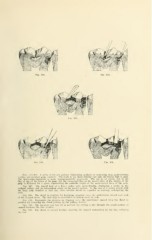Page 355 - My FlipBook
P. 355
Fig. 187. Fia. 188.
Fig. 189.
Fig. 191.
Figs. 187-19G. A series of ten pen pictvires illustrating niethoils of excavating deep niesio- occlusal
cavities and avoiding pulp exposure. The tooth ia cut mesio-dis tally and only the buccal half is used.
The dento-enamel-junction is made diagrammatically prominent. The cut is, of course, not in the
line of any of the horns of the pulp, but the recessional line of the mesial crest of the margin of the
pulp is darkened for a space, representing the probable lengtli of the mesio-buccal horn of the pulp.
Fig. 187. The buccal half of a lower molar split mesio-distally, displaying a cavity in the
occlusal surface and an independent cavity in the mesial surface. In the case of a young person with
the largo pulp chamber at that ago, the.se cavities should bo regarded as seriously endangering the
pulp.
Fig. 188. The chisel in position for beginning chipping away the undermined enamel over each
of the decayed areas. The first chip is represented as broken away in each.
Fig. ISO. Represents the progress in chipping away the undermined enamel with the chisel in
position for removing the distal portion by the pulling motion.
Fig. 190. The inverted cone bur 10 in position for cutting a slot through the sound portion of
enamel between the two cavities.
Fig. 191. The chisel or enamel hatchet removing the enamel undermined by the bur, widening
the slot.


